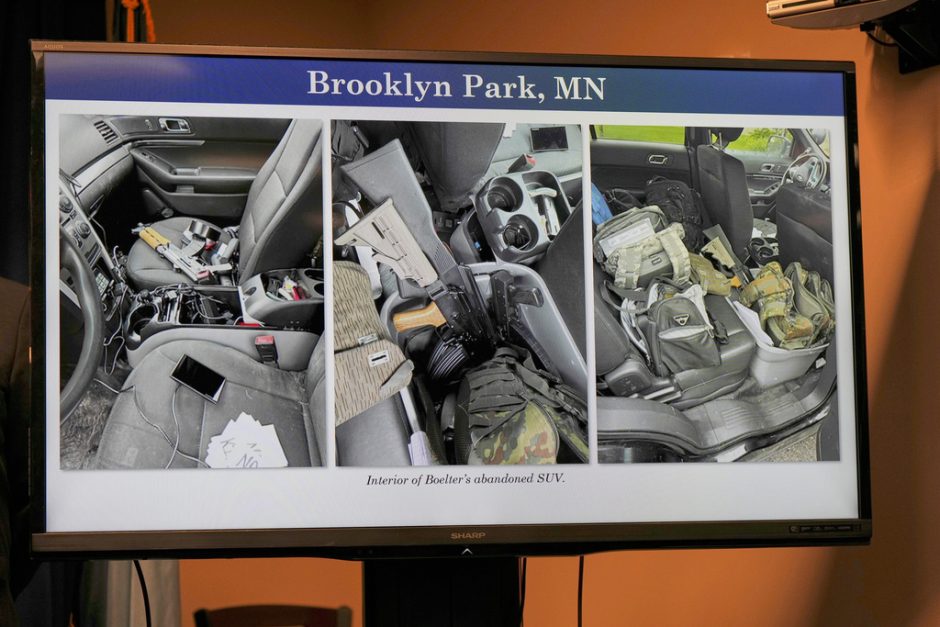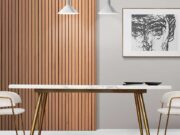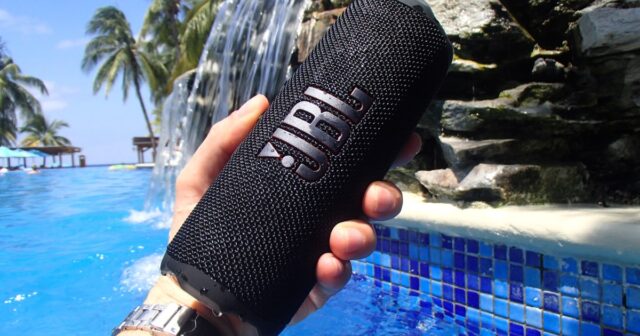“Some nice improvements keep JBL’s ultra-tough portable as a top pick in Bluetooth speakers.”
Pros
- Fully water- and dust-proof
- Great sound for its size
- Expandable with JBL Auracast
- USB-C lossless audio
- Decent battery life
Cons
- No speakerphone
- No analog input
Portable Bluetooth speakers are about as close as possible to a commodity in the audio world. One glance at Amazon and it’s obvious — there are hundreds of models to choose from. And yet, JBL’s new $150 Flip 7 proves that even in a sea of similar products, it’s possible for a Bluetooth speaker to stand out.
What’s changed?

Before we get into the details, a quick look at what JBL has changed on its seventh-gen version of the Flip:
- More battery life (16 hours versus 12)
- Better water protection (IP68 versus IP67)
- Lossless audio via USB-C
- Swappable attachments
- New EQ modes
- Increased total power (35 watts versus 30)
- AI Sound Boost
- Auracast stereo/party modes
- No longer comes with charging cable
- Price: The regular price of the Flip 7 is $20 more than the Flip 6
JBL Flip 7 specs
| Price | $150 |
| Size | 7.25 x 2.5 inches |
| Weight | 1.23 pounds |
| Power | 35 watts |
| Battery life | Up to 16 hours |
| Water/dust resistance | IP68 |
| Charging | USB-C |
| Inputs | USB-C for lossless, digital audio |
| Connectivity | Bluetooth 5.4 (SBC/AAC) |
| Stereo/mono | Mono |
| Stereo pairing/audio sharing | Yes/yes |
Design

Put the Flip 6 and Flip 7 side by side and you’ll be hard-pressed to spot the differences.
The Flip 7 retains the same shape and weight as its predecessor, which means it remains one of the best speakers for travelers. Shorter than a beer bottle, and weighing 1.23 pounds, it fits easily into a backpack or carry-on suitcase, which is exactly what I did on a recent vacation. You could probably stick it vertically into a car cupholder, though I admit I didn’t try that.
JBL has simplified the button layout. The PartyBoost button is gone, replaced by an Auracast button that now sits beside the power and Bluetooth pairing buttons, leaving just play/pause and volume up/down in the main position. That was a good call as it was all too easy to hit the PartyBoost button when fumbling for the volume-down button.

But the change that deserves the most attention (and praise) is JBL’s clever new “pushlock” mechanism. It lets you swap the two included attachments (a carry loop and a carabiner) instantly, depending on your needs. It’s way more versatile than the Flip 6’s single wrist strap, though some folks may miss it since the carry loop can only accommodate two fingers. Hopefully, JBL (or a third party) will make more pushlock accessories available in the future.
With an IP68 rating, it doesn’t get any more dust and waterproof than the Flip 7. It’s easily one of the toughest speakers you can buy. Just be prepared: it may be pool-proof, but it will sink like a stone if you let go.
Despite the USB audio option, there’s still no analog aux input. JBL steadfastly refuses to incorporate speakerphone functionality. If this is a must-have, the Beats Pill is an excellent alternative.
Sound

The Flip 6 and Flip 7 don’t just look alike, they also sound very similar — at least at first. You still get the remarkable JBL Flip experience with impressive amounts of volume and clarity for such a small speaker. Out of the box, the Flip 7’s treble is a bit boosted compared to the Flip 6. It has a slightly wider soundstage (despite still being a mono speaker), and there were moments when it felt deeper, too.
You’ll need to crank it up to hear these differences, which only become apparent above 50% volume.
But here’s a very serious recommendation: Download and install the JBL Portables app (iOS/Android). I know most folks don’t use apps for Bluetooth speakers since they just want to power them on, get connected, and start the tunes. Trust me, you want this one.
It’s the same app that lets Flip 6 owners modify EQ settings using a fairly basic three-band equalizer. But when a Flip 7 is connected, JBL offers an expanded set of options, including several EQ presets like JBL Signature, Chill, Energetic, Vocal, plus a custom mode that lets you dial in your own settings with a seven-band equalizer.
Ordinarily, I wouldn’t expect more EQ options to have a significant impact on the sound from two such similar speakers. However, a preset like Energetic unlocks way more low-end boost on the Flip 7 than you can achieve using the Flip 6’s three-band equalizer. It makes the Flip 7 far more versatile for those who want to achieve a different sound signature than the factory default.
JBL also uses an AI Sound Boost algorithm on the Flip 7, which may help contribute to its better performance. The company claims that it can “optimize the speaker driver without distortion.” Since distortion often creeps in when lows are boosted, it’s possible JBL kept the Flip 6 from attempting to reproduce these frequencies, while the Flip 7 has been given more leeway.
Still, some distortion manages to make its way into the mix. It’s noticeable on tracks that have ultra-low bass lines (like Billie Eilish’s bad guy), and the louder you play, the more noticeable it gets. Overall, the Beats Pill is a cleaner choice, even if it can’t match the Flip 7’s pure output in terms of power.
Lossless audio

New for the Flip 7 is the ability to plug the speaker directly into a USB-C output on a computer, phone, or tablet for lossless audio. For this to work, you’ll need a data-capable cable with at least one USB-C end and JBL doesn’t provide one in the box.
You’ll also need to press the play button as you insert the USB cable into the speaker, otherwise the Flip 7 assumes you’re just trying to charge it.
Does it make a difference? Yes, but it’s subtle. If you have access to lossless content (e.g. most music services except Spotify or YouTube Music), you may be able to hear an improvement in detail. For me, that translated into a more relaxed sound, with less shouty highs and lows that were a little less boomy.
To be clear, even with a lossless connection, the Flip 7 won’t be anyone’s idea of a hi-fi speaker, but there’s still an improvement.
Unfortunately, the speaker can’t charge while in USB audio mode, so you’ll still need to periodically take it out of USB audio mode. It also won’t maintain a Bluetooth connection, which means the it will stick with the last EQ setting you enabled.
Stereo pairing and party mode with Auracast
JBL has transitioned its wireless speaker sharing tech from its proprietary PartyBoost to the newer, Bluetooth LE Audio Auracast standard. In theory, this could enable the Flip 7 to tune into public Bluetooth broadcasts, but that’s not how JBL uses it.
Instead, it takes advantage of Auracast’s one-to-many sharing feature to give the Flip 7 an almost unlimited amount of expandability. Pressing on the Auracast button lets any other Auracast-enabled JBL speaker (like the Xtreme 4 or Charge 6) play the same audio as the Flip 7. And since JBL is adding Auracast to its entire line of portables (including its party speakers), that’s a lot of potential expansion choices.
Using the JBL Portables app, you can also stereo pair two of the same speakers (two Flip 7s, two Charge 6s, etc.). I didn’t get a chance to test the stereo pairing, but audio sharing works seamlessly.
The real downside to the switch to Auracast is that the Flip 7 can no longer audio share with previous PartyBoost or JBL Connect speakers. Auracast-enabled models now exist in their own separate ecosystem.
Fun fact: pressing play/pause on a secondary Auracast speaker mutes just that speaker, but pressing that button on the primary speaker pauses the music on all connected speakers.
Battery life

JBL claims the Flip 7 gets up to 14 hours of playtime per charge, a small but nice bump over the Flip 6’s 12 hours. However, there’s also a new PlaytimeBoost mode that can be activated via the app, which can purportedly extend that time another two hours. This comes at the expense of disabling any EQ settings you may have applied, but if you’re far from a power source, that seems like a worthy tradeoff.
I didn’t spend enough time with the Flip 7 to fully test these numbers, but my usual caveat on battery life still applies: unless you limit yourself to 50% volume, you likely won’t get the stated endurance.
It’s worth noting that if battery life is a key concern, for the same price as the Flip 7 you can get the new Beats Pill, which packs an astonishing 24 hours of claimed power.
Conclusion
For most folks, portable speakers are supposed to fun, handy, (and affordable!) accessories for casual listening. If you’re not fussy about small improvements in sound quality, save some money and grab the JBL Flip 6 now that it’s discounted. It’s still a great speaker. If you already own a Flip 6 (or even a Flip 5), you shouldn’t feel any need to upgrade at this time.
On the other hand, the Flip 7 moves the needle on sound quality, ruggedness, and battery life. Admittedly, not by major amounts, but enough to justify the $20 price increase.

















































